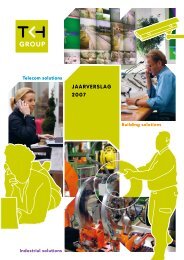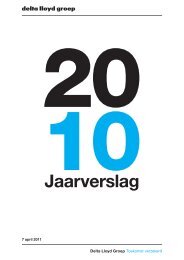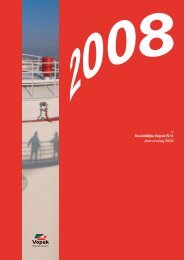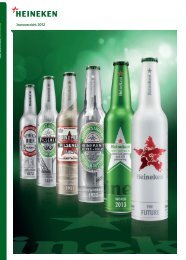TNT Express Annual Report 2011
TNT Express Annual Report 2011
TNT Express Annual Report 2011
Create successful ePaper yourself
Turn your PDF publications into a flip-book with our unique Google optimized e-Paper software.
Business performance<br />
Chapter 2<br />
led to sub-optimal capacity utilisation of <strong>TNT</strong> <strong>Express</strong>’ own fleet of intercontinental aircraft. Profitability<br />
was also negatively affected by high fuel costs.<br />
At the beginning of <strong>2011</strong>, <strong>TNT</strong> <strong>Express</strong> operated four Boeing 747 freighters to and from Asia, serving<br />
Chongqing, Hong Kong, Shanghai and Singapore, two of which were on short-term leases. This<br />
capacity was reduced at mid-year in line with weaker demand. However, at the end of the year, <strong>TNT</strong><br />
<strong>Express</strong> took delivery of three Boeing 777 freighters. Measures are being taken to limit exposure to<br />
volatile and weaker Asia demand. In 2012, <strong>TNT</strong> <strong>Express</strong> intends to further explore capacity reduction<br />
measures including sale of some operations, subleases and capacity sharing arrangements.<br />
Domestic China successfully continued its targeted growth of day-definite product to reduce the<br />
proportion of LTL services. Day-definite grew by more than 100% year-on-year and represented at yearend<br />
almost 30% of revenues (2010: 15), well on track to realise the projected 40% of revenues in 2013.<br />
Australia recovered strongly, after enduring flooding and strikes in the first quarter of <strong>2011</strong>, due to a<br />
combination of successful yield management and cost control initiatives.<br />
V. AMERICAS<br />
GENERAL<br />
In South America, <strong>TNT</strong> <strong>Express</strong> has key positions in the domestic express market in Brazil and Chile,<br />
realised through the acquisitions of <strong>Express</strong>o Mercúrio and <strong>Express</strong>o Araçatuba in Brazil and LIT Cargo<br />
in Chile. In Brazil, <strong>TNT</strong> <strong>Express</strong>’ network covers 140 locations. Its service offering to customers is<br />
supported by fully automated hubs and the application of leading track-and-trace technology. The region<br />
is connected via the South American Road Network.<br />
<strong>TNT</strong> <strong>Express</strong>’ operations in North America provide full service capabilities to its customers both in North<br />
America and on other continents. <strong>TNT</strong> operates a dedicated service from Europe to New York,<br />
supplemented by commercial linehaul. <strong>TNT</strong> <strong>Express</strong>’ four gateways (New York, Los Angeles, Chicago<br />
and Miami) feed a nationwide parcel distribution network that relies upon a combination of own<br />
operations, regional partners and commercial airlines. Through this configuration, <strong>TNT</strong> <strong>Express</strong> is able<br />
to provide next-day before 3:00 pm delivery service to many key metropolitan areas across the United<br />
States.<br />
<strong>2011</strong> PERFORMANCE<br />
Year ended at 31 December <strong>2011</strong> variance % 2010<br />
Adjusted revenues 474 (5.6) 502<br />
Adjusted operating income (125) (39)<br />
Average consignments per day ('000) 54 (11.5) 61<br />
Revenue per consignment (€) 1 34.3 7.5 31.9<br />
Average kilogrammes per day ('000) 3,289 (18.2) 4,023<br />
Revenue per kilogramme (€) 1 0.56 14.3 0.49<br />
1 based on reported revenues @avg10 rates<br />
(in € millions, except percentages)<br />
In 2010, <strong>TNT</strong> <strong>Express</strong> pursued the integration of the two acquired Brazilian businesses, <strong>Express</strong>o<br />
Mercúrio and <strong>Express</strong>o Araçatuba. The complexity of the integration process was underestimated and<br />
resulted in process and systems failures in addition to the loss of critical employees, which in turn<br />
severely affected administrative and service quality. This culminated in the loss of major customers at<br />
the beginning of <strong>2011</strong>.<br />
Significant revenue losses and higher costs (inflation, service quality recovery and provisions) led to a<br />
significant negative operating income for the year.<br />
In the spring of <strong>2011</strong>, a full turnaround plan was initiated which included changes in the management<br />
team, organisational structure and key processes and controls. These actions restored service levels<br />
and ensured better controlled administrative processes. On-time delivery performance was above 95%<br />
in the last quarter of <strong>2011</strong>. On the back of solid operational performance, sales initiatives were<br />
undertaken. These resulted in a significant reduction of the revenue gap in the last quarter of <strong>2011</strong>. By<br />
the end of the year, with operations stabilised, the focus turned to controlling costs. The turnaround<br />
target of the second half of 2012 is reiterated.<br />
27

















